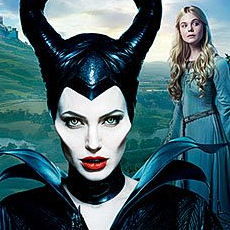Walt Disney Pictures (2014), Walt Disney Home Entertainment (November 4 2014), Blu-ray and DVD Combo Pack with Digital Copy, 97 mins plus supplements, 1080p high-definition 2.40:1 widescreen, DTS-HD 5.1 Master Audio, Rated PG, Retail: $36.99
Storyboard:
Walt Disney’s classic Sleeping Beauty is retold from an alternate and enlightening new perspective…
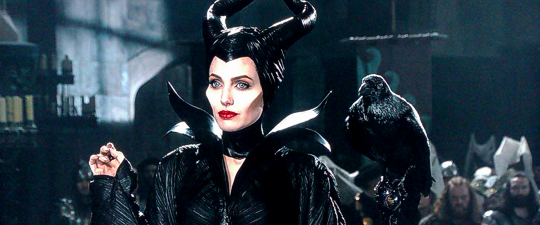
The Sweatbox Review:
With the upcoming Cinderella, another retelling of The Jungle Book and more from Glenn Close’s Cruella de Vil on the way (not counting that character’s imminent introduction to Once Upon A Time or even the in development Beauty And The Beast and, um, new Dumbo), Disney has found itself on something of a winning streak in mining its back catalog of animated classics for future hits. It’s a clever ploy: one that updates a story for modern audiences but doesn’t desecrate the original, and in fact also brings new attention to an older film that, in this day and age, might have gone forgotten. With bright and shiny new CG now the family format of choice, even Disney’s prestigious hand drawn features have seen a decline in popularity.
Once upon a time the jewels in the crown of the Disney Studio’s library, these animated films were reissued on a seven year cycle, allowing for new generations to discover the previously timeless features whose color, characters and music transcended the decades and, largely, any form of ageing. That was, however, until CG animated comedies replaced the traditionally drawn fairytale features in the cartoon landscape, not only rendering the artform supposedly old-fashioned but inadvertently reducing the interest level from today’s kids in almost everything that came before the advent of our current century.
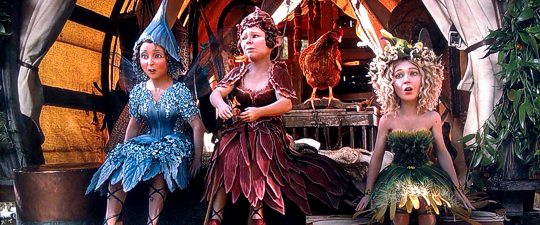
The decline hasn’t just been a result of changing audience trends: that seven-year cycle concept switched its design to the home video market in the 1990s (pretty much the last time any of the golden age Disney features were reissued theatrically), where the idea that titles are released periodically from a “vault” is slightly offset by the fact that these films have mostly – and incredibly sadly – become TV filler fodder, with the previously “untouchable” likes of Fantasia and even Snow White And The Seven Dwarfs now licensed for playing on a screen shared with channel idents and commercial interruptions.
But even in the world of TV and home video, the Disney classics – now mostly near or well past their 70th birthdays – seem to finally be reaching the end of their profitable lives (something that usually happens within five to ten years of an average film leaving theaters, so they’ve had an exceptional run), so how do you bring new attention to them and breathe new life into a title to extend and expand a potential franchise? Disney has found a way, mostly thanks to new CG technology that can create a “live-action” version of films previously only achievable in animation, and creating these “alternate takes” that don’t resort to shot-by-shot remake tactics or pretend to be worthy animated follow-ups like the much derided “cheapquels” attempted in the 1990s and 2000s.
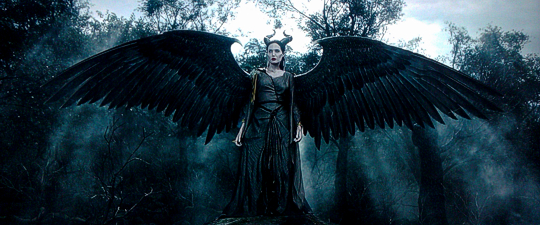
Walt himself was always looking for fictional stories to turn into live-action productions, even since the monies raised by his early animated films’ releases in England was held back and had to be reinvested in the country following the devastation of World War II. Treasure Island and the likes of The Story Of Robin Hood And His Merrie Men (both of which would conversely be retooled as animated features much later in the Studio’s timeline) were born from this era, formulating Walt’s approach to television and such adaptations of pulp and comics heroes as Zorro in the 1950s. I can’t quite put my finger on any specific animation property that Walt adapted to live-action, the earliest such connection with the Disney Studio being its collaboration in 1980 with Paramount on the ill-fated but underrated Popeye feature with Robin Williams.
In the 1990s the Studio continued with many more of these kinds of films, mostly licensing characters from other companies to create live-action updates for Mr Magoo, George Of The Jungle and Inspector Gadget…all pretty risible films, while not much better was to be found in the likes of My Favorite Martian or a straight remake of Ray Harryhausen’s Mighty Joe Young – not a bad film in itself but one that still pales next to the awesome and ingenious visual effects of the original. Better was to come with a trio of period adventures that ripped their inspiration direct from the comics pages (Who Framed Roger Rabbit, Dick Tracy and The Rocketeer), but perhaps Roger Rabbit’s huge success pointed towards the one element all these other endeavors lacked: a pure connection to the Studio itself.
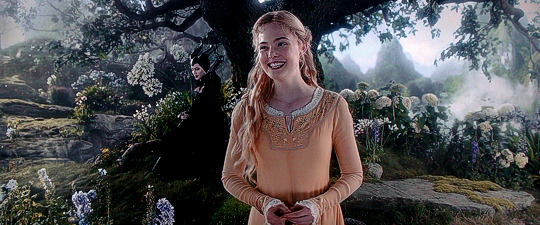
This oversight would soon be rectified after a successful early 90s reissue of one of Walt’s most contemporary pictures, One Hundred And One Dalmatians, inspired a full-blown remake. Thankfully arriving just before the advent of computer graphics made the moving of live-action animals’ mouths possible, the resulting 101 Dalmatians was by turns a welcome alternate version of Dodie Smith’s original book as well as being frustratingly tied to Walt’s first screen translation. But with the might of the Disney marketing division behind the release it was a bona fide hit on par with the kinds of returns the animated films usually brought in, leading to a plundering of the Disney catalog that even saw the company’s theme park rides (Haunted Mansion, The Country Bears) being mined for franchise potential.
The only one of these films to stick was Pirates Of The Caribbean, launching not only a series of its own but a revival of the pirate genre in general. The rewards were proven to be so huge when a title got it right that it wasn’t a surprise when the Studio announced Alice In Wonderland would next be getting the live-action treatment. Walt’s original certainly had its fans, but by taking a less than widely praised film, and not to mention a perennially popular novel by Lewis Carroll in the first place, the Studio cleverly picked a title that couldn’t specifically be traced back to the earlier film – after all, the story had been made for the screen well before and since Walt’s 1951 version. With Tim Burton at the helm and Pirates’ Jack Sparrow himself, Johnny Depp, in the cast, Alice was an unexpectedly huge hit, paving the way for a sequel to Carroll’s own follow-up novel.
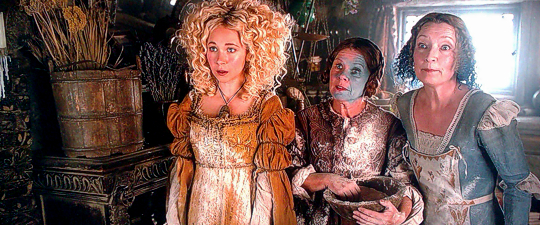
Alice opened the floodgates to Disney selecting other animated titles from its library to refresh, and as much as that film was not explicitly based on the Studio’s own earlier version, the latest in this new run, Maleficent, more than certainly is, continuing and confirming this streak in a way perhaps unimaginable just a few short years ago. Sharing not only its basic plot in the fairytale of Sleeping Beauty, but also its specific Disney depictions of characters and even production design, Maleficent really was a bit of a gamble for the Studio, and it must have been a huge challenge to undertake…something that I could absolutely understand and appreciate when I saw the film on theatrical release earlier this year.
It sounds trite to say it, but Maleficent truly is magnificent. Perhaps in no way as has been achieved before, a Disney animated classic finds a genuine visual soulmate in a live-action adaptation, where the new film not only stands side-by-side the 1959 classic but shoulder-to-shoulder with it too. This is easily attributable to two very obvious highlights in the film: Angelina Jolie’s extraordinary (yes, extraordinary) portrayal of the title character and the exquisitely realized fairytale kingdom she and the rest of the cast reside. Taking their cue from Sleeping Beauty’s own Evynd Earle, Maleficent’s world is like a Disney ride come to life, a fully realized, photo-real kingdom that melds elements you may have seen before – or think you have seen before – into something new and not always inviting.

As befitting a story in which the “hero” is a villain – let’s call her an “anti-villain” – not everything is as sweet and rosy as it was in the earlier film. Everything has a more lived-in quality and many of the other characters, not only Maleficent herself, have ulterior motives and various shades to their personalities. Put this down to Beauty And The Beast screenwriter Linda Woolverton’s adaptation (reuniting with that film and her Lion King producer Don Hahn, an executive producer here), using the animated film to springboard off into something of a prequel and combined retelling so as to explain Maleficent’s reasons for her ruthlessness – reasons that are actually compelling and, despite some changes late in the plot, feel totally authentic.
Which brings us to the film’s masterstroke of casting in Jolie herself, a fan of the original film and especially of Maleficent. Basing her look on animator Marc Davis’ designs (nicely, he gets a screen acknowledgment, even if it does come right at the end of the credits), director Robert Stromberg and Jolie refashion Maleficent from a purely evil caricature to one that can hold a modern, post-Lord Of The Rings (with which it shares some touches) visual effects heavy blockbuster in the twenty-teens. Yes, some may feel that yet again we’re asked to accept the touchy-feely explanation as to why a character may have turned “bad”, but there’s more to Maleficent than just that, and turning back the clock to before the events of Walt’s film is Woolverton’s other clever concept.
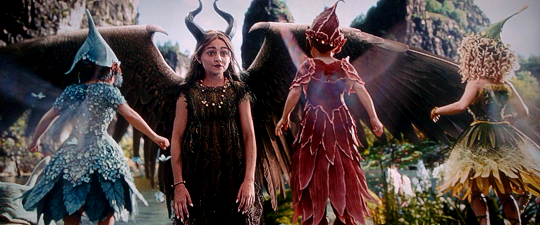
Here we meet a young Maleficent, one with the enchanted world around her, although that is soon to change when less enchanted human traits lead to betrayal and sets characters down the path of revenge, eventually crossing paths with the nominal lead of the original story, Aurora (a delightfully real-looking Elle Fanning, fresh from making such an impact in Super 8). Although I’ve been praising the film so far, I have to say I found Maleficent’s “good fairy” look still to be on the, well, malevolent side, what with her black horns such a huge feature. Maybe it wasn’t what I was expecting, feeling that her earlier, sweeter look was offset by the horns we know from the dark character we’ve seen before, and had figured that at some point she would have grown these horns as a way to make her look more fearsome.
This backstory explained, we move on into the Sleeping Beauty we’re more familiar with, although don’t go in expecting this to be a straight told version of the tale. There are various elements, for instance, that I felt were a shame to change from the original film for no particular reason: the three fairies tasked with watching over princess Aurora, the cursed King and Queen’s daughter, Flora, Fauna and Merryweather, for example, have found their names changed without any apparent indication why, while they still retain their red, blue, green coloring of the same characters’ designs in the animated film. Likewise, Maleficent no longer has an army of goblin henchmen but rather relies on just her crow, now also able to transform into various beasts in order for her to carry out her wishes.
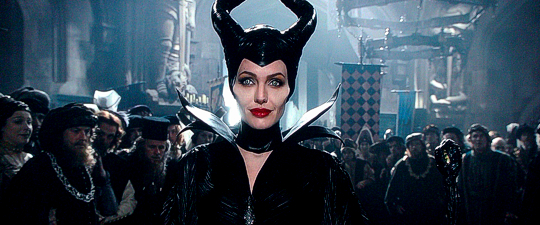
Biggest change of all is that – spoiler alert – Maleficent no longer transforms into a dragon at the story’s climax – indeed the whole final moments of the story have been retrofitted to accommodate the look perspective we have on the title character. Quite why she couldn’t have a series of animals to do her bidding is perhaps explained by having an actor she can bounce dialogue and ideas off, while suggesting she has a horde of cronies available to her could become too big and messy a concept to satisfy successfully, but I still feel she could have revealed her full power and “gone dragon” in the film’s final battle, if only to play on the scaly connection that would have been enforced by her horns and those of the dragon’s itself.
However, as great an engrossing entertainment as Maleficent may be, it is not without its slight irritants such as these; on one hand wishing to be faithful and true to the original animated picture but on the other imbuing the revamped story with one or two too many embellishments that seemingly stray from that intention. I’m not talking about Sharlto Copley’s King’s actions, which spur the story on and in actual fact make a great deal of sense in this version of events, but about things such as the rearranging of the outcome of Aurora’s not-so-deep sleep (though I won’t mention the obvious flaw in the King’s plan and what he probably should have disposed of pretty early on!), even if the brave new take on “love’s true kiss” is an interesting choice that does work here.
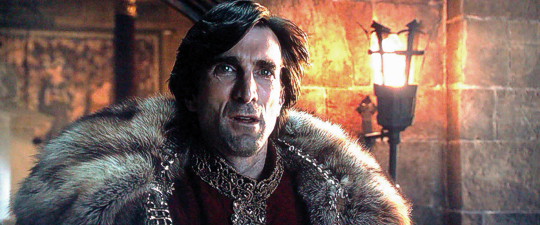
Thank goodness, then, for Angelina, who transcends any and all of these ultimately minor issues and really proves herself (as if she needed to anyway) after a series of high-profile but somewhat empty roles that played more to her strengths as a celebrity. Here she seems to have found what once excited her about acting again, and what continues to push her as a director. Maybe it’s the deep-rooted image of Maleficent from childhood that helps her connect with something inside her, but whatever it is, she totally makes the character her own to the extent that this is a real performance and not just some phoned-in comic book play acting, raising the whole film to a higher level beyond that of what a typical summer blockbuster, of which she has much experience, needs to achieve.
Whether it was director Stromberg – a visual effects supervisor handed his directorial debut with this highly visual film – who was responsible for drawing out this response to the material, or whether it was Saving Mr Banks’ helmer John Lee Hancock, who came to the Maleficent set on Disney’s request to undertake some reshoots, that helped Jolie connect with the role in the way she does, she is exemplary. In some scenes theatrical but never to the point of being absurd, in others being malevolent and living up to her character’s name, and again finding the exuberance in the role or the hurtful pain in certain scenes (one wonders if and how the effect of her much-publicized double mastectomy had on the moment she finds her wings have been shorn…certainly it’s a subject raised with most women I know who have seen the film), Jolie simply gives an awards worthy portrayal.
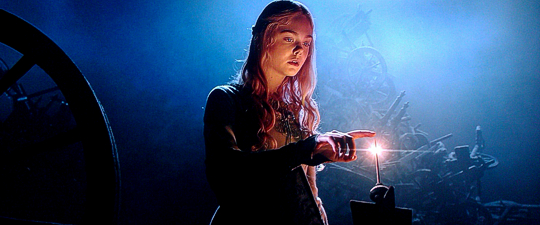
My hope is that Maleficent doesn’t go forgotten by the time awards season begins: as a supposed mindless summer blockbuster the film is in danger of being classed as something it is so much more than. Audiences, for once, responded in the right way, building on Disney’s immense surprise success of Frozen to come out in force for a similar kind of tale, singing and dancing notwithstanding (that comes this Christmas with the Disneyfied screen version of Stephen Sondheim’s fairytale satire Into The Woods) and making Maleficent almost as big a hit. So, sure the movie has made a lot of money, but it shouldn’t be forgotten the way many summer movies are in time: this is otherwise a classy, classic film that I hope sticks around for many summers to come and which I hope is deservedly recognized – Jolie especially – when those awards start getting handed out.
Is This Thing Loaded?
As big a hit as Maleficent was, you’d be expecting Disney to pull out all the stops – and to be fair there are a few pulled out here indeed – but as usual for a Disney title the extras package falls well short of the kind of commentaries and extensive supplements that grace titles from the Studio’s other divisions such as Pixar and Marvel, both of which are regularly treated to such bonuses as feature-length documentaries and crammed second discs worth of content. Perhaps of the extended production that saw Hancock step in to reshoot some elements, a commentary might not have been forthcoming for obvious awkward reasons, but the rest of what’s here, although fairly in-depth, doesn’t feel as significant as it should for one of the year’s biggest and largely acclaimed films.

Focusing initially on Fanning’s depiction of the princess herself, Aurora: Becoming A Beauty speaks to the actress for almost five minutes about her inspiration from the original animated film, combined with on-set footage and clips, including an awful-looking Sleeping Beauty – didn’t someone at Disney tell them there’s a new Blu-ray out!? From Fairy Tale To Feature Film continues the discussion in a slightly longer eight minutes, expanding to include Jolie, writer Woolverton and others of the cast and crew’s perspective and their approach to translating the Disney original and wanting to remain faithful to it (although the question of why they then changed certain elements goes answered).
With the script process and development covered, Building An Epic Battle takes us to the fields of England to witness one of the film’s huge sequences in which as much was done for real as it was blended with the final CG, and this near six minutes certainly covers a lot of ground. Shorter at well under two minutes but no less important is the slightly oddly produced Classic Couture, where designer Justin Smith runs us through some of the film’s props, specifically Jolie’s Maleficent headdress, in a bit of a bonkers, avant garde clip. Back on the blue-screen stage and on-set, Maleficent Revealed is essentially a glorified visual effects reel, providing lots of shots from the movie mixed montage style into a near five-minute series of before and after wipes and dissolves…all very grand and impressive but without a scrap of context for those that don’t know what they’re looking at.
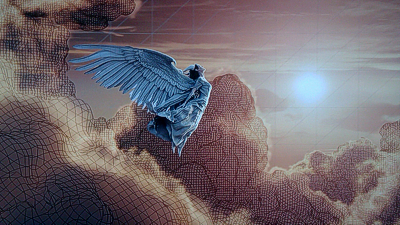
Lastly, the same can be said for the almost seven minutes of Deleted Scenes, of which there are five. Director Stromberg is hardly heard from in any of these supplements (I think I noted one soundbite), so it’s disappointing but hardly surprising that he isn’t on hand to introduce the cuts here (title cards provide a little info and these moments are all virtually completed). On the Blu-ray, notable Sneak Peeks include teasers for Cinderella and Once Upon A Time’s new season – but not the almost concurrently released Sleeping Beauty or, most strangely, the similarly aimed Into The Woods, which could suggest Disney doesn’t have much hope for that film’s chances this Christmas? Certainly exposure here would have been a natural fit and made sure that a lot of eyes saw the just-released new trailer for the film, so it’s very odd that it’s a no-show here.
Case Study:
Maleficent had a number of good promotional images released ahead of release, but the resulting posters never really caught the perfect mix, I didn’t think, and the sleeve art here, using one of those posters as a basis, is again somewhat hampered what with Jolie taking center stage but without much to do and Fanning’s Aurora almost looking like she’s walked in by mistake and photobombed the shoot! It seems to be an issue of placement: other versions make the same elements work much better, such as the standalone DVD edition. This set comes bundled with that same DVD included, which features just Aurora: Becoming A Beauty as an extra, all housed within a glossy and lightly embossed slipcover, in initial pressings, which replicates the sleeve art including a weird shot of the back of Jolie in character, and a lame and obvious “wickedly good” quote which the copywriter apparently liked so much they use it again in the back cover blurb!
Ink And Paint:
Post-converted to 3D for theatrical showings, Disney has been offering Maleficent in that format in some international countries but has again chosen not to give the option in the US, presumably because in home video terms 3D has been dying a slow death and even Disney, at one time a huge proponent of the format, has mostly abandoned such releases other than for their Marvel superhero titles where fanboy demand is no doubt a little higher for those wanting to show off their home theater set-ups with the added dimension.
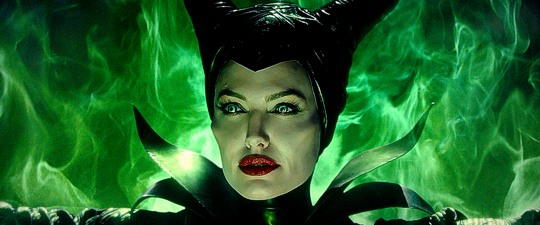
On one hand I can see how fangirls would be disappointed in not being able to show off their set-ups with such a visually striking film as Maleficent, but on the other I really don’t think anyone is missing much. This is such a rich and sumptuous film to look at, and this Blu-ray image is so strikingly perfect as to reach into, that I can’t see anyone really feeling the need to complain outside of just wanting another option for the sake of it. One of the best films of the year gets one of the best transfers of the year. ’Nuff said.
Scratch Tracks:
James Newton Howard’s exquisitely intricate and often haunting score has stayed with me since my theatrical viewing, and it’s great to hear it again in context here. Yes, there’s a theme in there that I can’t quite put my finger on as sounding like something else, but it could also just be that it’s the perfect score for the film it accompanies. Purists would probably have liked to have heard the Tchaikovsky ballet music playing throughout as per the 1959 film, but even that played hard and fast with the original score and JNH’s approach is so lyrical as to be sublime. Mixed in with a premium-grade movie soundtrack, Maleficent is as aurally stirring as it is visually. English, French and Spanish dubs and subs are all optional.
Final Cut:
Under a half-hour of extras doesn’t really cut it in this day and age, especially for one of the major hits of the year and a film that turned out to be such a worthy surprise. What there is does cover an awful lot of ground, but I expect fans were hoping for much more than soundbites and set footage for a film of this kind – I know I was. Disney isn’t a company known for including trailers for a movie on its respective disc, but I’m surprised we don’t even get the Lana Del Rey music video for her haunting recreation of Once Upon A Dream, a sorely missed opportunity to bolster up what is a very slim package given the appeal of the film.
Certainly Maleficent is terrific, modern, blockbuster moviemaking, but it’s also infused with a classic sensibility, probably inherited from Walt’s original Sleeping Beauty than consciously achieved. It’s a film that will surely stand the test of time, with characters that transcend whoever is playing them. That Jolie does such a startling and thorough job in the title role is testament to her abilities as an actress, and I really wouldn’t be surprised if she doesn’t get a round of awards nods for her “anti-villain”, just as much as the film deserves to be recognized in other areas. If only Disney’s own home video team realized that as well!
 | ||
 |


